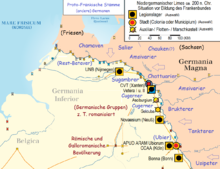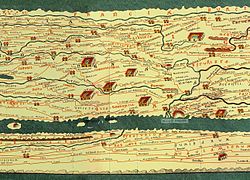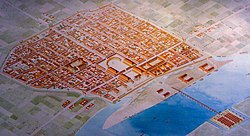Franks
The Franks (meaning "the brave, bold") were one of the major Germanic tribes. They formed in the 3rd century around the part of Germania occupied by the Romans through alliances of several small tribes.
The Franks (Franci in Latin) were first mentioned in contemporary sources in 291 in a panegyric to the emperors Diocletian and Maximian. Around 360/61, the late ancient Roman historian Aurelius Victor reported in his Kaiserviten that the peoples of the Franks (Francorum gentes) had already ravaged Gaul by the end of the 250s. Salian Franks (also called Salians) and Rhine Franks initially expanded spatially separately - the Salians via Toxandria into Gaul, the Rhine Franks via the Middle Rhine and the Moselle region southwards and into the former Roman province of Gallia Belgica on the left bank of the Rhine. Frankish warriors served the emperor as foederati in the 4th and 5th centuries before founding the most important Germanic-Roman successor empire in the west in the transition from Late Antiquity to the Early Middle Ages, where the last Western Roman emperor had been deposed in 476. In the years around 500, the Merovingian king Clovis I united the sub-unions of the Salian Franks and the Rhine Franks for the first time and created the Frankish Empire, which experienced its greatest expansion under the Carolingian Charlemagne.
Franks and the native population mixed linguistically and culturally over time. The Gallo-Roman vernacular dominated in the west, the Frankish language in the east, with a linguistic border forming in between until the 9th century. The majority of the Sal Frankish later merged into the people of the French and Walloons. The Sal Franks on the IJssel and the Lower Rhine, as well as the Moselle and Rhine Franks, retained their Franconian dialects into modern times and merged into the peoples of the Germans, Dutch, Lorraine, Luxembourgish, and Flemish. The modern region of Franconia historically formed the eastern settlement area of the tribe. Its inhabitants are still referred to as Franks today.
Under Charlemagne's grandsons, the great Frankish Empire was initially divided into three parts. The Middle Kingdom of Lorraine was divided between the East Frankish Empire and the West Frankish Empire in 870. From the East Frankish Empire (the later Holy Roman Empire) emerged the successor states of Germany, the Netherlands, Belgium and Luxembourg, as well as Switzerland, Liechtenstein, Austria, parts of Italy and East-Central European border areas. The West Frankish Empire gave rise to the successor state of France.

Location on the border of the Lower Germanic Limes - Germanic tribes before the "Frankish Genesis
The situation at the Lower Rhine Limes
The Lower Germanic Limes was the border between the Roman province of Germania inferior on the left bank of the Rhine and the barely controlled Germania Magna on the right bank at the turn of the century. This section of the limes, beginning at about the present-day Bad Breisig and ending at the mouth of the Altrhein into the North Sea, was determined primarily by the course of the river itself, rather than by ramparts or walls. Roman forts and fortifications stretched along the river via Nijmegen, Xanten, Neuss, Cologne to Bonn, where the Upper Germanic Limes began somewhat upstream on the opposite side of the Rhine. In this protective zone, a large number of Roman estates (villae rusticae) and settlements (vici) were built in the hinterland on the left bank of the Rhine; the imperial city of Trier functioned as an important sign of Roman power in the Gallo-Roman-Germanic borderland.
In the large area between the Rhine and the Ardennes, however, there were also Germanic villages and settlements that lived in dependence on Roman institutions. The Germanic tribes settling to the right and left of the Rhine were thus familiar with Roman culture, civilization and military technology; Germanic tribes were active to varying degrees in the service of the Romans, not infrequently as military alliance troops. The tribe of the Ubians was settled by the Romans around 15 BC in what is now Cologne and gradually Romanized - this also applied to the Batavians in the Dutch Betuwe. There were repeated raids by Germanic groups against Roman establishments, which could also escalate into larger conflicts.
Rome's internal problems with tributary emperors and counter-emperors in the 3rd century (see Imperial Crisis of the 3rd Century) had also had a destabilizing effect on the situation in Gaul and Germania. This was later compounded by the unrest of the incipient Migration Period and the conflicts of the Romans with Goths and other Germanic tribes. This was the period in which Germanic groups and tribes of the Germania Magna on the right bank of the Rhine first formed into action communities, then into tribal confederations and finally into new peoples - this applies to the Franks as well as to the Saxons, Alamanni, Thuringians, Bavarians and Burgundians.

Detail of the Tabula Peutingeriana, with Francia, the land of the Franks, in the upper margin

Roman Cologne, 3rd to 4th century before it was conquered by the Rhine Franks (diagram in the Römisch-Germanisches Museum)
The Franks before the Franks
The (proto)Frankish tribes or associations initially settled on the right bank of the Rhine, often changing their settlement area and repeatedly advancing into Gallo-Roman territory on raids. Although the demarcation of the sub-tribes from each other and from other Germanic tribes is sometimes fraught with uncertainty, the Frankish tribes appeared to the Romans as a linguistic and ethnic unit that went beyond the narrow tribal name.
The "inner perception" of the tribes among themselves, however, was at first more differentiated. In the beginning they formed only loose alliances, as they were suitable for raids or defensive measures. In the course of time, this "tribal swarm" gave rise to a tribal federation or tribal confederation (of which, according to Zöllner, it is essential to speak) and only in the course of time finally to the people. In recent research (Patrick Geary, Michael Kulikowski et al. ) it is increasingly assumed that the union of the Franks was initially promoted by the Romans, who wanted to bring the Limes foreland under control in this way.
When the Imperium Romanum went through a period of weakness in the 3rd century, however, Franks, Alamanni and Saxons took advantage of this to launch raids. The first known Frankish raids into Roman territory took place in 257/59 and increased more and more in the following period. However, the mention for these first Frankish raids is found in a later late antique source in Aurelius Victor (c. 360); the first mention of the Franks in a contemporary source is again found in a Panegyricus from 291. When the Roman Empire had stabilized again, many Franks served in the Roman military and some rose to high positions. The expansion of the Franks from the northwest and east across the Rhine created a certain pull for the Germanic tribes (Frisians, especially Saxons, also Thuringians), which always provided points of contact, fighting, but also small alliances across tribes.
In a Roman road map from the middle of the 4th century - the Tabula Peutingeriana - the "Francia" (the land of the Franks) on the right side of the Rhine was already explicitly marked.
Whether one can speak of Frankish "tribes" in this period is controversial; some scholars (Guy Halsall et al.) regard the groupings rather as mercenary troops. In any case, Frankish ethnogenesis was a process drawn out over a long period of time. From when on the development to a common "people feeling" was completed cannot be exactly determined historically; however, during the time of the initially spatially separated actions of Salian Franks and Rhenish Franks there were always contacts between the federations and joint actions against common enemies. For the Merovingian Clovis I it was therefore easy in 509, after the elimination of the Ripuarian rex Sigibert of Cologne, to place himself also at the head of the federation of the Rhine Franks, since these saw him, like themselves, as "Franks".
Questions and Answers
Q: Who were the Franks?
A: The Franks were a Germanic federation of tribes formed out of several Germanic tribes, including the Salians, Sicambri, Chamavi, Tencteri, Chattuarii, Bructeri, Usipetes, Ampsivarii, and Chatti.
Q: Where did most of the Franks live?
A: Most of the Franks lived at the northern borders of the Rhine.
Q: What areas did the Franks conquer and establish a kingdom in?
A: The Franks conquered and established a lasting kingdom in an area which eventually covered most of modern-day France, Belgium, the Netherlands, and the western regions of Germany.
Q: When did the Franks confederacy emerge?
A: Modern scholars of the period of the migrations are in agreement that the Frankish confederacy emerged at the beginning of the third century.
Q: What was the significance of the pagan Frankish king Clovis becoming Christian?
A: When the pagan Frankish king Clovis became Christian in the late 5th century that was an important event in the history of Europe.
Q: What is Salland and why is it significant to the Franks?
A: Salland is a region in the northeast of the modern-day Netherlands that may have received its name from the Salians, who formed the core of the Frankish sea raiders.
Q: What rivers did the Franks enter the late Roman Empire from?
A: The Franks entered the late Roman Empire from the north and east river bank of the Rhine into modern northern Belgium and southern Netherlands.
Search within the encyclopedia